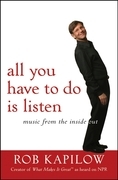
Rob Kapilow has been helping audiences hear more in great music for almost twenty years with his What Makes It Great? series on NPR, at Lincoln Center, andin concert halls throughout the US and Canada. In this book, he gives you a set of tools you can use when listening to any piece of music in order to hear its “plot” - its story told in notes. The musical examples are available free for download to help you hear the ideas presented. Whether you are an experienced concertgoer or a newcomer to classical music, the listening principles Kapilow shares will help you "get" music in an exciting, fresh new way. "Kapilow gets audiences in tune with classical music at a deeper and more immediate level than many of them thought possible." - Los Angeles Times. "Rob Kapilow is awfully good at what he does. We need him." - The Boston Globe. "A wonderful guy who brings music alive!" - Katie Couric. "Rob Kapilow leaps into the void dividing music analysis from appreciationand fills it with exhilarating details and sensations." - The New York Times. "You could practically see the light bulbs going on above people's heads. The audience could decipher the music in a new, deeper way. It was the total opposite of passive listening." - The Philadelphia Inquirer. Rob Kapilow is a composer, conductor, pianist, and music commentator. His What Makes It Great programs, which began on NPR, have been developed into full-length concert evenings that are a mainstay of Lincoln Center's Great Performers series, and are presented on a recurring basis in Boston, Washington, DC,and Kansas City, and in California at Cerritos and Palo Alto. They have also been turned into CD recordings and video podcasts. He appears regularly throughout the United States and Canada, both with What Makes It Great and FamilyMusik, and has been featured in print and on television, including on NBC's Todayshow and PBS's Live from Lincoln Center. INDICE: PREFACE. ACKNOWLEDGMENTS. HOW TO USE THE WEB SITE. PRELUDE: All You Have to Do Is Listen. 1. Does Music Have a Plot? 2. Beginnings Are Everything. 3. Repetition. 4. Comma, Semicolon, Period: The Meaning of Cadence. 5. Compared-to-What Listening. 6. Forward-Backward Listening. 7. The Challenge of Memory. 8. Form Is a Verb. 9. From Dancing to Listening: Minuets and Scherzos. 10. Sonata Form: A Story in Three Acts. 11. Passacaglia, Chaconne, and Fugue: Out of One, Many. 12. How Could This Come from That?: The Art of Theme and Variations. 13. The Individual versus the Community: The Concerto. 14. Finished versus Complete. POSTLUDE: The Role of the Performer. GLOSSARY. CREDITS. INDEX.
- ISBN: 978-0-470-38544-9
- Editorial: John Wiley & Sons
- Encuadernacion: Cartoné
- Páginas: 256
- Fecha Publicación: 19/09/2008
- Nº Volúmenes: 1
- Idioma: Inglés
